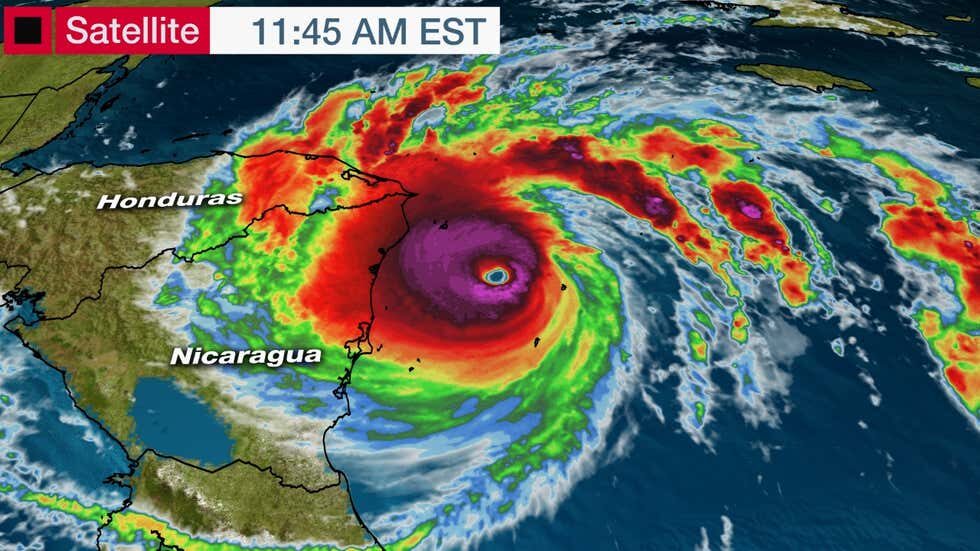
© The Weather Channel
Hurricane Iota has rapidly intensified into a rare Category 5, the first of the 2020 Atlantic hurricane season, as it heads for landfall in Central America, where it will bring potentially catastrophic rainfall flooding, mudslides, storm surge and damaging winds for the second time in two weeks.
Late Monday morning, Iota became only the second Category 5 hurricane on record in November and the record latest-in-season hurricane ever to reach that intensity in the Atlantic Basin. The 1932 Cuba hurricane reached Category 5 intensity from November 5-8.
The upgrade to Category 5 intensity was based on both satellite intensity estimates and a Hurricane Hunter mission, which measured flight level and surface winds sufficiently strong enough.
Hurricane warnings have been issued for portions of Nicaragua and Honduras, where hurricane conditions are expected by later Monday. Tropical storm warnings extend to the west and south of the hurricane warnings in both of those countries.
A tropical storm warning and a hurricane watch are also in effect for Columbia's San Andrés Island.
Iota will make landfall late Monday night along the coast of northern Nicaragua, in the same area Hurricane Eta made its Category 4 landfall on November 3.Incredibly, some additional intensification is possible as Iota tracks through a favorable environment that includes plenty of deep, warm water, favorable upper-level winds and a lack of dry air. It's possible Iota could landfall at Category 5 intensity, though an eyewall replacement cycle is possible before landfall that could cap out its intensity.
Regardless, Iota is likely to be a catastrophic hurricane for Central America.This will be the first time on record two major hurricanes - Category 3 or stronger - made landfall in Nicaragua in the same hurricane season, much less only two weeks apart. NOAA's hurricane database only documented seven such Category 3-plus landfalls in Nicaragua prior from the mid-19th century through 2019.
Potentially Catastrophic Impacts AgainRainfall FloodingOnce again, flooding rainfall is expected to be one of the biggest dangers for Central America, including areas that were devastated by Eta's heavy rain earlier this month.
Eta's flooding impacts killed at least 120 in Central America and southern Mexico, according to the latest report from The Associated Press. Scores of people are still missing, the AP said. Honduras was one of the areas hardest hit by Eta's flooding and any additional rain could worsen conditions.
The National Hurricane Center has issued the following rainfall forecasts through Thursday:
-Honduras, northern Nicaragua, southeast Guatemala and southern Belize may pick up 10 to 20 inches, with isolated totals up to 30 inches. Areas from northeast Nicaragua into northern Honduras could see the heaviest totals.
-El Salvador and Panama can expect 4 to 8 inches, with local totals up to 12 inches
-Southern Nicaragua and Costa Rica can expect 3 to 5 inches, with localized totals of up to 10 inches
This rainfall will lead to dangerous, life-threatening flash flooding, river flooding and landslides.
According to NOAA meteorologist Alex Lamers, combined rainfall totals from Eta and Iota
could match yearly average rainfall in parts of Honduras.
Storm SurgeA life-threatening, potentially catastrophic storm surge of 15 to 20 feet above normal tide levels is expected north of where Iota makes landfall, along the northern coast of Nicaragua and coast of eastern Honduras.
Destructive, battering waves will ride atop the surge.
WindsPotentially catastrophic winds of
Category 5 intensity can be expected in the eyewall of Iota as it makes landfall late Monday night into early Tuesday morning in northeast Nicaragua or extreme southeastern Honduras.
This will lead to severe structural damage, particularly to poorly-built structures, and widespread power outages in northeast Nicaragua and eastern Honduras by Tuesday morning.
As mentioned earlier, hurricane conditions are expected by late Monday within the hurricane-warned area in northeast Nicaragua and eastern Honduras.
More Storm NotablesMaximum sustained winds in Iota increased from 85 mph to 155 mph in the 24 hours ending 7 a.m. EST on Monday. That easily met the criteria for the rapid intensification of a tropical cyclone, which is an increase in maximum sustained winds of at least 35 mph in 24 hours or less.
Iota is the
10th storm of the 2020 season to meet the criterion for rapid intensification. This tied 1995 for the most such rapid intensifiers in any single season since 1979, according to
Tomer Burg, an atmospheric science Ph.D. student at the University of Oklahoma.
Iota's 160 mph maximum sustained winds on Monday morning makes it the strongest hurricane of the 2020 Atlantic season. It also topped Hurricane Lenny (1999) for the strongest Atlantic hurricane so late in the season, according to Dr. Phil Klotzbach, a tropical scientist at Colorado State University.
Comment: See also: